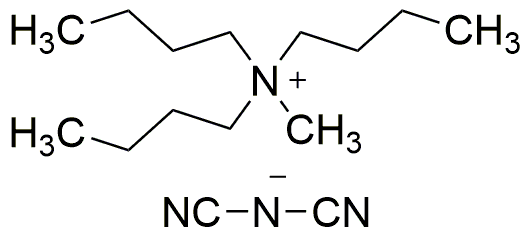Tributyl(methyl)ammonium dicyanamide is widely utilized in research focused on:
- Electrolytes in Energy Storage: This compound serves as an effective electrolyte in supercapacitors and batteries, enhancing energy density and charge-discharge rates, which is crucial for the development of efficient energy storage systems.
- Green Solvents: It acts as a green solvent in various chemical reactions, providing a more environmentally friendly alternative to traditional solvents, which is increasingly important in sustainable chemistry practices.
- Polymer Chemistry: The compound is used in the synthesis of ionic liquids and polymers, contributing to materials with unique properties, such as improved thermal stability and conductivity, beneficial for industries like electronics and materials science.
- Pharmaceutical Applications: It has potential uses in drug formulation and delivery systems, where its unique properties can enhance solubility and bioavailability of active pharmaceutical ingredients, addressing challenges in drug development.
- Catalysis: This chemical is explored as a catalyst in various organic reactions, offering advantages like increased reaction rates and selectivity, which can lead to more efficient manufacturing processes in the chemical industry.
General Information
Properties
Safety and Regulations
Applications
Tributyl(methyl)ammonium dicyanamide is widely utilized in research focused on:
- Electrolytes in Energy Storage: This compound serves as an effective electrolyte in supercapacitors and batteries, enhancing energy density and charge-discharge rates, which is crucial for the development of efficient energy storage systems.
- Green Solvents: It acts as a green solvent in various chemical reactions, providing a more environmentally friendly alternative to traditional solvents, which is increasingly important in sustainable chemistry practices.
- Polymer Chemistry: The compound is used in the synthesis of ionic liquids and polymers, contributing to materials with unique properties, such as improved thermal stability and conductivity, beneficial for industries like electronics and materials science.
- Pharmaceutical Applications: It has potential uses in drug formulation and delivery systems, where its unique properties can enhance solubility and bioavailability of active pharmaceutical ingredients, addressing challenges in drug development.
- Catalysis: This chemical is explored as a catalyst in various organic reactions, offering advantages like increased reaction rates and selectivity, which can lead to more efficient manufacturing processes in the chemical industry.
Documents
Safety Data Sheets (SDS)
The SDS provides comprehensive safety information on handling, storage, and disposal of the product.
Product Specification (PS)
The PS provides a comprehensive breakdown of the product’s properties, including chemical composition, physical state, purity, and storage requirements. It also details acceptable quality ranges and the product's intended applications.
Certificates of Analysis (COA)
Search for Certificates of Analysis (COA) by entering the products Lot Number. Lot and Batch Numbers can be found on a product’s label following the words ‘Lot’ or ‘Batch’.
*Catalog Number
*Lot Number
Certificates Of Origin (COO)
This COO confirms the country where the product was manufactured, and also details the materials and components used in it and whether it is derived from natural, synthetic, or other specific sources. This certificate may be required for customs, trade, and regulatory compliance.
*Catalog Number
*Lot Number
Safety Data Sheets (SDS)
The SDS provides comprehensive safety information on handling, storage, and disposal of the product.
DownloadProduct Specification (PS)
The PS provides a comprehensive breakdown of the product’s properties, including chemical composition, physical state, purity, and storage requirements. It also details acceptable quality ranges and the product's intended applications.
DownloadCertificates of Analysis (COA)
Search for Certificates of Analysis (COA) by entering the products Lot Number. Lot and Batch Numbers can be found on a product’s label following the words ‘Lot’ or ‘Batch’.
*Catalog Number
*Lot Number
Certificates Of Origin (COO)
This COO confirms the country where the product was manufactured, and also details the materials and components used in it and whether it is derived from natural, synthetic, or other specific sources. This certificate may be required for customs, trade, and regulatory compliance.


